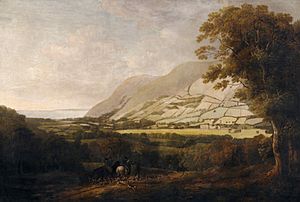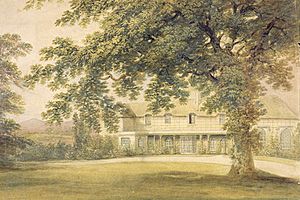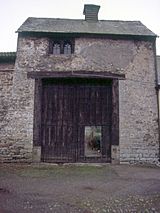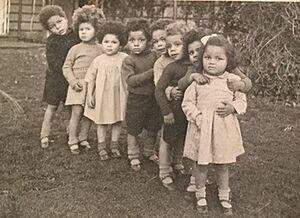Holnicote Estate facts for kids
Quick facts for kids Holnicote Estate |
|
|---|---|
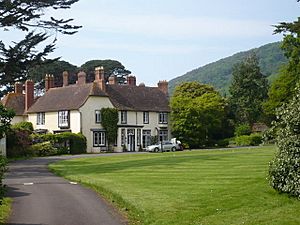
Holnicote House
|
|
| Location | Exmoor, England |
| Lua error in Module:Location_map at line 420: attempt to index field 'wikibase' (a nil value). | |
Holnicote (pronounced "Hunnicutt") is a large, historic piece of land in Somerset, England. It covers about 12,420 acres (5,026 hectares). Much of this land is inside the beautiful Exmoor National Park.
Over the last 500 years, several houses have stood on the Holnicote estate. A new mansion was built in 1705 but burned down in 1779. It was rebuilt as a hunting lodge, but another fire in 1851 destroyed it. A new house was built ten years later. Holnicote became a key place for the Devon and Somerset Staghounds, a famous hunting group. The main building was damaged by another fire in 1941.
In 1944, Sir Richard Thomas Dyke Acland gave the house and the land around it to the National Trust. Today, the house works as a hotel. The surrounding land includes Dunkery and Selworthy Beacons. It also has the villages of Selworthy, Allerford, Bossington, Horner, and Luccombe. The Dunkery and Horner Woods National Nature Reserve is also part of the estate. There are more than 240 kilometers (150 miles) of footpaths and bridleways for people to explore.
In the 1200s and 1300s, the de Holne family owned the estate. Later, in the 1600s, the Staynings family were the main landowners. By the 1700s, the Martyn family took over. William Martin sold Holnicote to William Blackford. The estate then passed through his family and later to the Dyke family. Sir Thomas Acland married into the family, and the estate stayed with the Aclands until it was given to the National Trust in 1944.
Contents
History of Holnicote Estate
Early Times

The name Holnicote has been spelled in different ways, like Honecote or Hunecote. Some think it comes from an old English word for holly, holegn. Others believe it means "The Honey Cottage" from honeg and cot. One local historian thought it came from an old English personal name, Hùn.
Holnicote is mentioned several times in the Domesday Book. This was a big survey of England made in 1086 by William the Conqueror. The Domesday Book shows that different people owned parts of the land that is now Holnicote. For example, some land was held by two nuns.
It's hard to know exactly who owned Holnicote right after the Domesday Book. William de Holne held the land during the time of King Edward I. By the late 1400s, the Steynings family owned Holnicote. The earliest record of them is from 1491. The Steynings family continued to own the estate for many years.
Martyn and Blackford Families Take Over
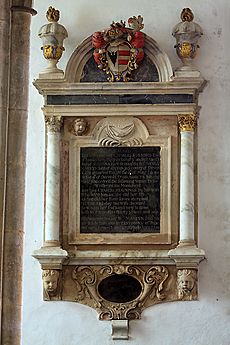
The Steynings family owned Holnicote until Charles Staynings died in 1700. His nephew, William Martyn, inherited the estate. William Martyn sold Holnicote to William Blackford, who was a Master in Chancery (a legal official). Blackford also bought other nearby lands.
William Blackford married Elizabeth Dyke. He died in 1728. His son, also named William, took over but died just three years later. His only daughter, Henrietta Blackford, inherited the estate as a baby. Sadly, she died at age 7 in 1733.
The estate then passed to Elizabeth Dyke, a relative of the family. In 1744, she became the sole owner of the entire Holnicote estate.
The Acland Family's Time
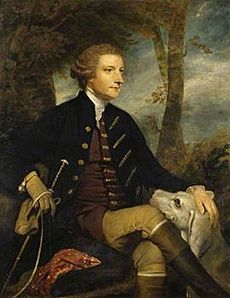
In 1745, Elizabeth Dyke married Sir Thomas Dyke Acland, 7th Baronet. He was a very important person in the West Country. Sir Thomas was famous for staghunting. He used his wife's Holnicote and Pixton estates on Exmoor as his hunting bases. He even built kennels for his hunting dogs.
Sir Thomas was known for being very generous. He would welcome all hunters to Holnicote or Pixton after a hunt. It is said that "open house was kept at Pixton and Holnicote throughout the hunting season." In 1779, a fire destroyed the house at Holnicote. Sir Thomas was sadder about losing his collection of stag heads and antlers than the house itself.
His second son, Sir Thomas Dyke Acland, 9th Baronet, took over the estate after his father and older brother passed away. Like his father, he loved staghunting. He spent most of his time at Holnicote and Highercombe, which were close to the ancient royal forest of Exmoor, known for its red deer.
The estate stayed in the Acland family until 1944. That year, Sir Richard Dyke Acland, 15th Baronet, gave the Holnicote and Killerton Estates to the National Trust. This was a huge gift, covering about 16,000 acres, and was the largest donation the National Trust had ever received.
Holnicote Estate Today
The Holnicote Estate is a large and beautiful area. It covers over 12,000 acres. There are more than 240 kilometers (150 miles) of footpaths and bridleways for walking, cycling, and horse riding.
The estate includes Dunkery and Selworthy Beacons. These are high points with amazing views. It also has the charming villages and hamlets of Selworthy, Allerford, Bossington, Horner, and Luccombe. The Dunkery and Horner Woods National Nature Reserve is also part of the estate.
Dunkery and Selworthy Beacons
Dunkery Beacon is the highest point on Exmoor and in Somerset. It rises to 1,705 feet (520 meters). From the top, you can see far across the moorland, the Bristol Channel, and even hills up to 86 miles (138 km) away. People have visited this spot since the Bronze Age. There are several ancient burial mounds here.
At the top of Selworthy Beacon, you can see the south coast of Wales across the Bristol Channel. The South West Coast Path also goes up this hill. In the 1500s, Selworthy Beacon was used as a lookout point. A beacon fire would be lit to warn of coming invasions. The hills are a deep purple color in summer because of the heather growing there.
Plants and Animals
Many different plants grow on the estate. These include ling and bell heather, gorse, sessile oak, ash, rowan, hazel, bracken, mosses, liverworts, lichens, and ferns. Some unique whitebeam tree species are also found here.
The estate is home to many animals. You might see Exmoor ponies, red deer, pied flycatchers, wood warblers, lesser spotted woodpeckers, redstarts, dippers, snipe, skylarks, and kestrels. Horner Woods is especially important for bats. It is home to 14 of the 16 UK bat species, including rare ones like the barbastelle and Bechstein's bat.
Villages and Features
Selworthy is a small village that includes hamlets like Bossington and Allerford. Bossington is near Porlock Bay. In the 1990s, rising sea levels created new salt marshes and lagoons here. Selworthy village was rebuilt in 1828 by Sir Thomas Acland. It was designed to provide homes for older and sick people from the Holnicote estate. Many cottages still have thatched roofs and are painted a creamy yellow.
Allerford is famous for its old packhorse bridge over the River Aller. This bridge is thought to be from the Middle Ages. The village also has thatched cottages, a forge, and an old-fashioned red telephone box. The West Somerset Rural Life Museum and Victorian School is located in an old school building in Allerford. It shows what rural life and schooling were like in the past.
The village of Luccombe is at the foot of Dunkery Hill. Horner is another village nearby, with a non-working watermill and two medieval packhorse bridges. The Dovecot at Blackford Farm is an old building from the 11th century. It was used to house doves and pigeons.
Since 2009, the estate has been part of a project to manage floods. Beavers were brought back to the area to help reduce flooding.
Holnicote House and Other Buildings
There have been at least four main houses at Holnicote over time. One was built between 1493 and 1521. A Grade II* listed gatehouse and a cottage were built in the early 1600s.
When the Blackford family bought the estate in 1705, they built a new mansion. Only the stable block from that building remains today. This house was destroyed by fire in 1779. The Acland family rebuilt it as a thatched hunting lodge. But this lodge also burned down in 1851 and was replaced in 1861. A kitchen was added in 1874. The estate also has several cottages, like Rose Bower and the 17th-century Butlers Cottage. An old brick granary from the 1700s is also on the estate.
Holnicote House in the 20th Century
Holnicote House was given to the National Trust in 1944 by Sir Richard Thomas Dyke Acland. His family had owned it since 1745. In 1936, the lodge became a hotel. However, another fire badly damaged it in 1941.
Children at Holnicote House During World War 2
In 1943, during World War 2, Holnicote House was used by Somerset County Council. At first, it was a nursery for children who were moved away from cities to keep them safe from bombing. Later, the council started taking in children born to white British mothers and Black American fathers (called GIs). These children often arrived as babies.
Somerset seems to be the only county that specifically provided homes for babies born to Black GIs. Since Holnicote House was a nursery, children stayed there until they were five years old. After that, they would go to foster families, be adopted, or move to homes for older children.
People who lived and worked at Holnicote House during this time often spoke fondly of their experiences there. In 1948, Life magazine published an article about these children, calling them "Britain's 'Brown Babies'". This article brought international attention to the estimated 2,000 children born from relationships between Black GIs and white British women during the war.
Today, Holnicote House is once again a hotel.
See also
- List of National Trust properties in Somerset


